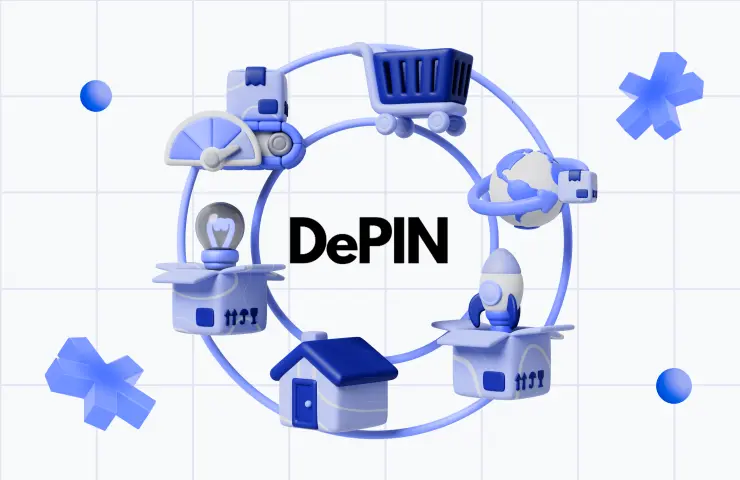Blockchain technology has revolutionized how we think about security and transparency in digital transactions. However, the ever-evolving digital landscape also brings unique challenges that require continuous innovation. One of the most promising advancements in this space is DePIN (Decentralized Physical Infrastructure Networks). By integrating physical infrastructure into decentralized networks, DePIN is addressing the limitations of traditional blockchain security and introducing new layers of protection. In this blog, we’ll explore Blockchain Security Innovations with DePIN, how it enhances security, and what the future holds for blockchain’s decentralized ecosystem.
Understanding Blockchain Security Challenges
Before diving into the innovations brought by DePIN, it’s essential to understand the security challenges blockchain faces today. While blockchain networks are considered more secure than traditional systems due to their decentralized nature, they are not immune to threats. Some of the common security risks in blockchain include:
- 51% Attacks: When a single entity controls more than 50% of a network’s hash rate, they can manipulate transaction data.
- Phishing Attacks: Fake platforms and deceptive tactics can lead users to give up their private keys, compromising security.
- Smart Contract Vulnerabilities: Poorly written smart contracts can be exploited, leading to financial loss.
- Centralized Points of Failure: Even decentralized networks often rely on some centralized elements, creating vulnerabilities.
These challenges highlight the need for continuous security innovations. This is where Blockchain Security Innovations with DePIN come into play, offering a decentralized infrastructure that bolsters blockchain’s security framework.
What is DePIN?
DePIN stands for Decentralized Physical Infrastructure Networks. It is a model where physical infrastructure like servers, storage, and network nodes are decentralized and spread across a wide range of independent operators, making the network more resilient and secure. This infrastructure supports blockchain networks by enhancing their physical distribution, leading to increased security, redundancy, and reliability.
The integration of DePIN into blockchain technology represents a fundamental shift in how we approach security. Instead of relying on centralized data centers or infrastructure providers, DePIN ensures that the physical components supporting the blockchain are equally decentralized. By doing so, Blockchain Security Innovations with DePIN offer a more secure and robust environment for users and developers alike.
How DePIN Enhances Blockchain Security
One of the core advantages of DePIN is its ability to enhance blockchain security by addressing vulnerabilities that centralized infrastructure creates. Here are several ways DePIN achieves this:
- Improved Node Decentralization: Traditional blockchains can still be vulnerable if their infrastructure is centralized. By distributing physical nodes across different geographical locations and independent operators, DePIN ensures that no single entity can compromise the network.
- Protection Against DDoS Attacks: Distributed Denial of Service (DDoS) attacks attempt to overwhelm a network with traffic, making it unavailable to users. DePIN mitigates this by spreading infrastructure across multiple nodes, making it difficult for attackers to target the network successfully.
- Defense Against Sybil Attacks: In Sybil attacks, a single malicious actor creates multiple fake nodes to take over or disrupt the network. DePIN makes such attacks much harder by decentralizing the network and ensuring that each node is independently managed, reducing the likelihood of fake nodes gaining control.
- Enhanced Consensus Mechanisms: DePIN strengthens blockchain’s consensus mechanisms by distributing infrastructure, ensuring that no single node or group can manipulate the consensus process. This prevents dishonest actors from altering transaction records or creating false blocks.
The innovation introduced by Blockchain Security Innovations with DePIN helps make blockchain networks more secure, transparent, and resistant to both external and internal threats.
Innovations in Blockchain Security via DePIN
The real innovation brought by DePIN is the way it incorporates physical infrastructure into a traditionally digital ecosystem. Here’s how these innovations manifest in blockchain security:
1. Physical Infrastructure Integration
One of the most significant Blockchain Security Innovations with DePIN is the seamless integration of decentralized physical infrastructure with digital networks. Unlike traditional blockchains that depend on a few centralized data centers, DePIN distributes the load across multiple locations, reducing single points of failure and increasing resilience.
2. Increased Redundancy
Redundancy is critical in blockchain security. If one node or server fails, others can pick up the slack. With DePIN, the infrastructure is designed with high levels of redundancy, ensuring that no single failure can disrupt the network. This protects the blockchain from potential data loss or downtime, enhancing overall security.
3. Dynamic Security Models
DePIN introduces dynamic security models that adapt based on the threats facing the network. By constantly monitoring the infrastructure, DePIN can identify potential vulnerabilities and automatically redistribute resources to safeguard the network. This adaptability is one of the key Blockchain Security Innovations with DePIN.
Investing in SRP Token allows you to be part of Blockchain Security Innovations with DePIN, enhancing decentralized security and network resilience.
DePIN and Data Privacy
Beyond enhancing blockchain security, DePIN also plays a crucial role in protecting user privacy. Decentralized physical infrastructure offers superior protection against centralized data breaches, which are common in traditional systems. Here’s how:
- Decentralized Storage: With DePIN, sensitive data is not stored in a single location, reducing the risk of large-scale data breaches.
- Encryption and Privacy Protocols: DePIN networks implement advanced encryption techniques to ensure that user data remains private and secure.
- Data Sovereignty: Users retain control over their data, allowing them to choose where and how it is stored, significantly improving privacy compared to centralized systems.
Blockchain Security Innovations with DePIN ensure that user privacy is a top priority, protecting sensitive information from unauthorized access and breaches.
DePIN’s Role in Securing Smart Contracts and DApps
Smart contracts and decentralized applications (DApps) are essential components of modern blockchain ecosystems. However, they are also vulnerable to attacks and bugs that can lead to security breaches. Blockchain Security Innovations with DePIN enhance the security of smart contracts and DApps in the following ways:
- Decentralized Execution: DePIN ensures that the infrastructure supporting smart contracts and DApps is decentralized, reducing the risk of tampering or manipulation by malicious actors.
- Resilience Against Exploits: By distributing the physical infrastructure, DePIN makes it more difficult for hackers to target specific components of a smart contract or DApp, ensuring the system remains secure.
- Real-Time Security Monitoring: DePIN networks often feature real-time monitoring of infrastructure to detect vulnerabilities and threats, allowing developers to respond quickly to security issues.
Future Prospects for Blockchain Security with DePIN
As blockchain technology continues to evolve, so too will the role of DePIN in securing these networks. The future of Blockchain Security Innovations with DePIN is bright, with several exciting developments on the horizon:
- Enhanced Cross-Chain Security: As more blockchain networks become interconnected, DePIN will play a critical role in ensuring security across multiple chains.
- AI-Driven Security Enhancements: The integration of AI and machine learning into DePIN networks could lead to even more dynamic and adaptive security systems.
- Expansion of DePIN Applications: Beyond blockchain, DePIN’s decentralized infrastructure could be applied to other industries, such as finance, healthcare, and IoT, further enhancing security in those areas.
Conclusion
Blockchain Security Innovations with DePIN represent a significant advancement in the world of decentralized networks. By integrating decentralized physical infrastructure, DePIN strengthens blockchain security, protects user privacy, and ensures the reliability of smart contracts and DApps. As we look toward the future, the continued growth and innovation in DePIN will undoubtedly play a critical role in shaping the security landscape of blockchain and beyond.
Whether you’re a developer, an investor, or simply interested in blockchain, understanding the impact of DePIN on security is essential. As the technology matures, the integration of DePIN will be key to addressing the challenges and ensuring the long-term success of blockchain ecosystems.

 China
China Russia
Russia India
India









